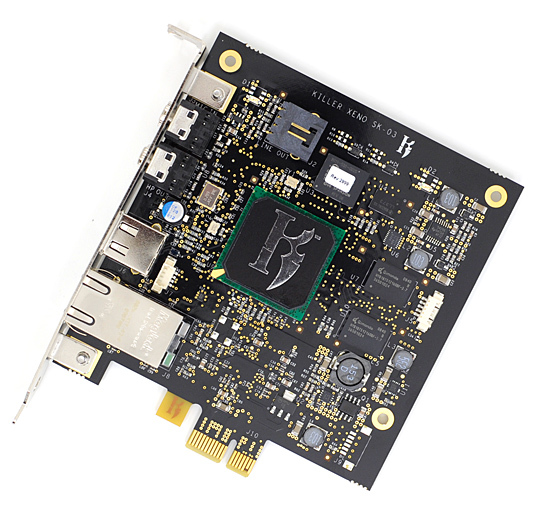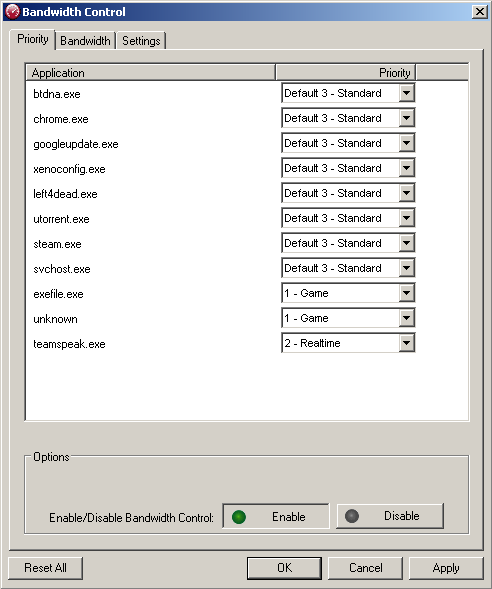EVGA Killer Xeno Pro: The Impact of Network Offloading
by Derek Wilson on July 3, 2009 4:20 AM EST- Posted in
- Networking
The Card and Features
This card sports a 400MHz PowerPC processor with 128MB of RAM, essentially making the Killer Xeno Pro a computer on a x1 PCIe board. As with the first generation, the major feature of the Killer Xeno Pro is it's ability to offload TCP/IP work from the CPU by bypassing the Windows TCP/IP stack.
Microsoft's built-in TCP/IP stack requires the CPU to handle network packet processing. Additionally, when packets arrive, they don't generate interrupts and applications must poll for data (which also wastes time and resources). Bigfoot Networks claims that the windows networking stack is not designed for low latency operation while the Killer Xeno Pro is. Regardless of how (or how efficiently) a software network stack is implemented, having it run in hardware will reduce overhead and impact on the rest of the system. It should also be noted that, for applications which require the windows networking stack (like some VPN products), the Killer Xeno Pro can disable it's "game mode" and enable "application mode" which does disable TCP/IP offload and can increase compatibility in some cases.
Adding to this, the Killer Xeno Pro hardware is capable of offloading other network centric tasks like VoIP, firewalls, and networked storage (though these features are not all fully supported with appropriate software at this point in time).

Installing the hardware is very straight forward, as it's just a simple PCIe card. If you want to use the voice chat features, the only additional need is to connect either the internal or external audio cable. No power is required, and other than that the network port is all that you'll need to worry about. Despite the fact that there is a USB port on the card, it is not used for anything at this point (but Bigfoot has indicated future potential to enable hardware managed USB attached storage).

Mic in and audio line out on a NIC; now that's a first.
The only installation issue we noted is that the driver install, when necessary, will also flash the Killer Xeno Pro hardware. There isn't very much warning about what's going to happen and no confirmation dialog before the start of the flash process. Those who click through install programs quickly without reading them might get themselves into a bit of trouble. There is no way to cancel the flash update once it's started, and while flashing hardware isn't as risky these days, it might be nice if the drivers were a little more clear about what was going to happen.

Easy mode switching.
The hardware comes with drivers and a tray application that are capable of bandwidth throttling and prioritization. Control can be down to a per application basis and maximum download and upload speeds can be specified. Or for benefit without the headache, applications can be prioritized allowing hardware and usage patterns to determine effective bandwidth. Unfortunately, the drivers and applications for the Killer Xeno Pro only run on Microsoft Windows operating systems (XP and Vista flavors). With the gaming focus, this makes sense, but it would still be nice for those who like to dualboot Mac OS X or Linux.

Per application QoS.

Per application bandwidth limits.
With software support, games and voice chat software can completely delegate any VoIP functionality to the Killer Xeno Pro which would handle taking input from the microphone (which plugs straight into the Killer Xeno Pro), compressing the data and sending it out over the network. When a voice packet is received by the Killer Xeno Pro, it decompresses it and sends it straight to the sound card (either via the soundcard's line-in port or an internal cable) bypassing the rest of the system completely. This should help reduce CPU overhead and voice lag caused by sources other than the network or server.
While this is great from a geeky technical standpoint, there isn't a huge amount of overhead on modern CPUs for voice chat software, and the network is by far the largest source of delay. So the actual benefit isn't going to be huge. These issues are the same with hardware firewall, bandwidth control, and all the extras.
The TCP/IP offload capability of the hardware will definitely remove another task from the CPU and operating system. This will free up resources that could be useful for other things, but the real world benefit of this will be very small in most games where the majority of the work is done on the GPU rather than the CPU. Having an NPU (network processing unit, as Bigfoot Networks likes to call it) that handles TCP/IP processing as soon as packets are received and uses hardware interrupts to let a game know that network packets have arrived (rather than requiring polling) can help decrease the latency between when a packet is received by the network card and when a game is able to make use of it, but as with the voice issue the largest delay is inherent in the internet itself and there is only so much benefit that can be had by optimizing the client side.
Not to say that optimizing client side networking is a bad thing: it certainly is not. The real question here is not whether the Killer Xeno Pro does something useful (because it does), the question is whether that useful thing has any significant impact on experience (and if that impact is high enough to justify the price).










121 Comments
View All Comments
Pirks - Friday, July 3, 2009 - link
"offload TCP/IP work from the CPU by bypassing the Windows TCP/IP stack" <<<--- THIS my friends if the proper fix for the infamous Vista MP3 network throttling issue. I wish this card were around when Mark Russinovich made his famous blog post.Zolcos - Friday, July 3, 2009 - link
Of course, internet latency is mostly dependent on the internet. Maybe I read this product wrong, but I always thought it was more for LAN gamers. After all, the client-side processing makes up a larger percentage of total latency on a fast LAN than over the internet. I'd like to see some game latency tests with a few computers on a gigabit LAN and no internet connection. Maybe even do a test with just a crossover cable between 2 Killer Xeno Pro cards to see "how low can you go".DerekWilson - Friday, July 3, 2009 - link
I'd like to do that sort of testing as well. We've only got one card in our labs right now though.andylawcc - Friday, July 3, 2009 - link
how much did they pay you guys to review this?james jwb - Friday, July 3, 2009 - link
the "Anandtech has gone down hill" troll remarks aren't going to reappear again, are they? The last few months it's been nice here...There was nothing wrong with this review. Bigfoot marketed it at gamers, it was reviewed with this in mind, and it's failed in that respect. The review was solid, if anything blame Bigfoot Networks. Got it?
DerekWilson - Friday, July 3, 2009 - link
Really?I was actually interested in finding out if it was any good.
And we did recommend that people not buy it ... so ... there's that.
crimson117 - Friday, July 3, 2009 - link
Okay then... um... how much did their competitors pay you to review it? Yeah!HerrK - Friday, July 3, 2009 - link
It would be nice to see how good the ping reduction for torrent+WOW is in comparisson to a software solution like CfosSpeed, which does the trick at my PC for yeras now. And I would like to see CPU-utilization compared to onboard NIC´s for GBit file transfers in an internal network. I'm aware that you wanted to show the real performance benefits for a gamer, but you know...Last, since this is my first post here, I would like to thank you all for your great work at Anandtech, it is one of the sites I check almost every day, and be delighted.
DerekWilson - Friday, July 3, 2009 - link
This could definitely be interesting and is something we would like to look into.we do really want to test with more than one card to see how it changes overall network performance.
hyc - Monday, July 6, 2009 - link
In my experience, having done a lot of heavy load testing on servers, you're only going to see any difference when you're near saturation of the network fabric. I.e., you need to be pushing enough packets to be at over 60% of the network's packet-per-second limit before you'll see any performance difference from any offload engine. For gigabit ethernet the maximum frame rate (at minimum frame size) is about 1.488M packets/sec. At anything less than 10% network utilization I doubt you'll even be able to measure the CPU overhead of network processing.